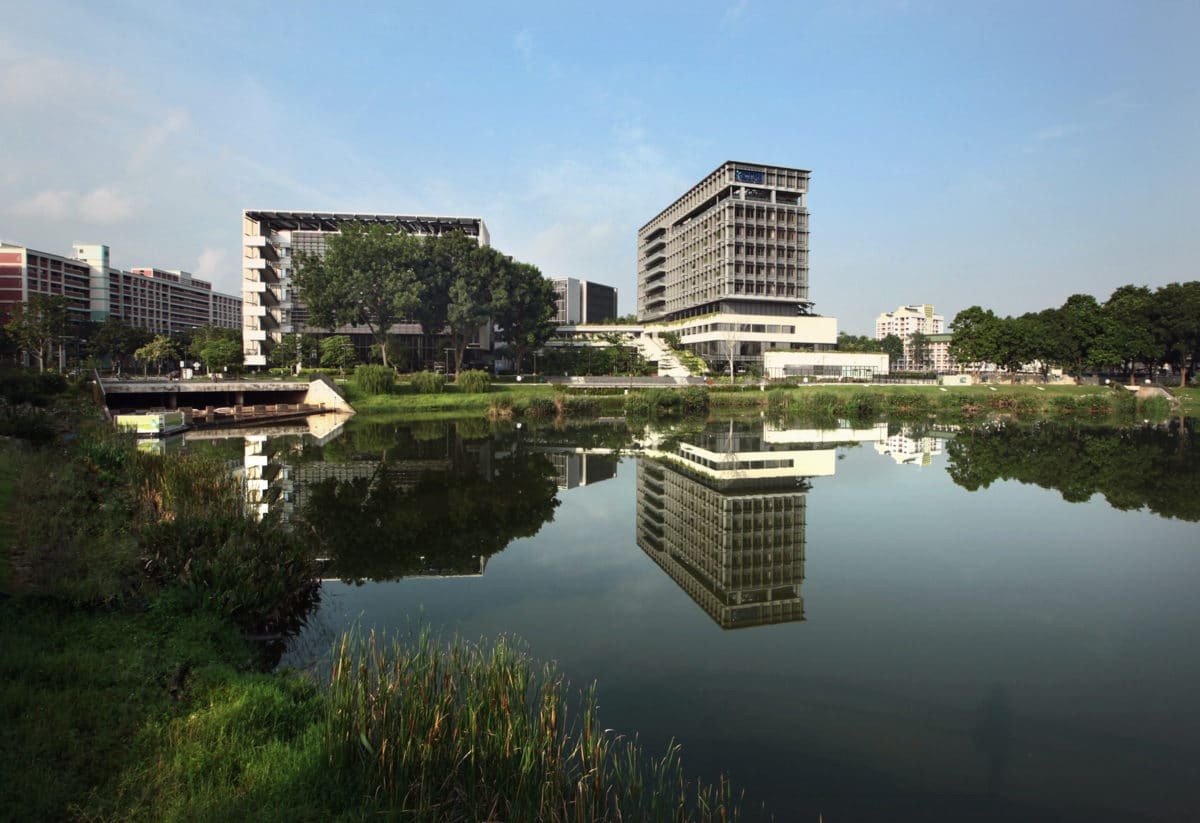Story at a glance:
- Stormwater retention systems are designed to store runoff and typically maintain a permanent pool of water between storm events.
- Retention ponds, wet bioswales, stormwater wetlands, and green roofs are all types of stormwater retention systems.
- Beyond collecting runoff, stormwater retention systems help prevent urban flooding, improve groundwater quality, and bolster biodiversity.
As extreme weather events become more and more common, the need for effective stormwater management is increasingly important, too.
There are many ways to deal with excess runoff and preventing urban flooding, and one of those ways is with stormwater retention systems.
This article is intended to serve as an introductory guide to the various types of stormwater retention systems and their benefits.
What is a Stormwater Retention System?
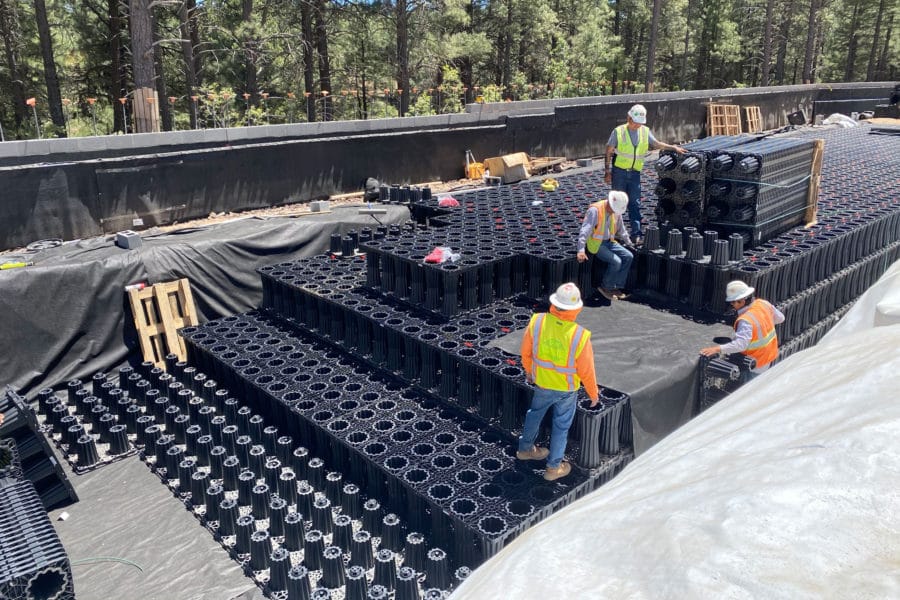
Stormwater retention systems—like ACO’s StormBrixx—are stormwater management devices designed to collect and store surface runoff. Unlike stormwater detention systems, retention systems maintain a permanent pool or store of water throughout the year. Photo courtesy of ACO
As the name implies, stormwater retention systems are designed to retain water—that is, they collect and store rainwater/runoff without subsequent surface discharge after a storm event has passed. This means stormwater retention systems maintain a permanent pool of water between runoff events, wherein stored water is forced out and wholly or partially replaced by runoff from each new rain event.
The only time stormwater retention systems are completely dry is during extended periods of drought or if they are intentionally drained for maintenance purposes. Regional climatic conditions may, however, dictate that the system only possess a permanent pool of water during the wet season.
Unsurprisingly, the main purpose of stormwater retention systems is to prevent runoff from entering municipal sewer systems and nearby water bodies. Retention systems are typically constructed in places where groundwater is naturally high and already close to the ground’s surface, as this helps ensure they hold a permanent supply of water year-round.
Stormwater Retention vs Detention
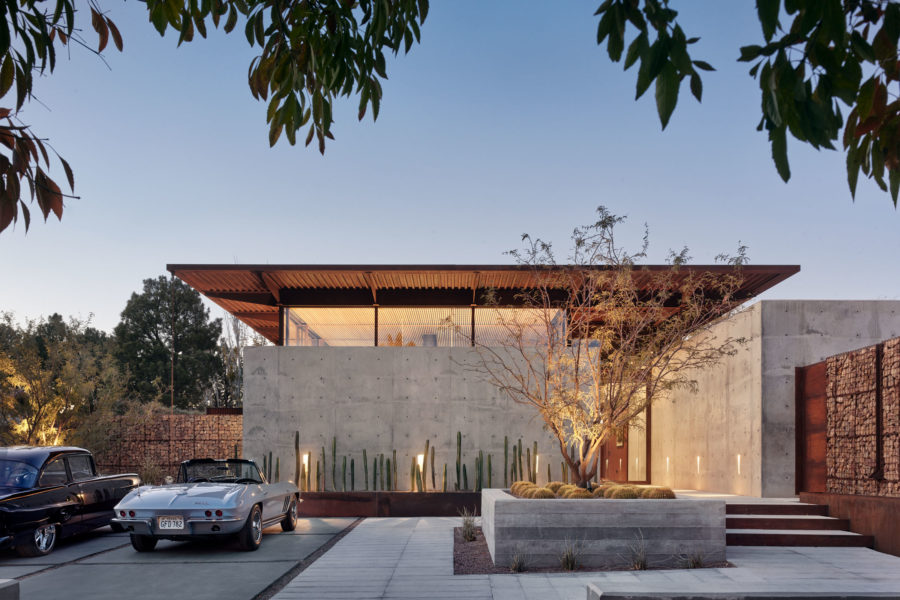
The Courtyard House—designed by Lake|Flato—employs a large underground stormwater detention system to help recharge the groundwater table. Photo by Casey Dunn
Let’s take a moment to address the differences between stormwater retention and stormwater detention, as the two terms are often used interchangeably despite referring to two different stormwater management practices.
- Retention. As previously mentioned, stormwater retention systems store runoff for the long term and maintain a permanent pool of water in between rainfall events; the only time water leaves these systems is if it is displaced by new runoff, pumped out for use elsewhere, evaporates, or if it naturally infiltrates the soil.
- Detention. Stormwater detention systems, on the other hand, are designed to temporarily collect rainwater and runoff; these systems gradually release all of their stored water soon after the storm has passed and so do not retain pools of water between runoff events.
Rainwater detention systems—especially underground ones—can be an ideal stormwater management solution in high-density urban areas with limited space, as well as in regions whose climatic conditions make maintaining a permanent pool of water year-round impossible or impractical.
The Lake|Flato-designed Courtyard House in El Paso, for example, resides in a dense suburban neighborhood that receives less than nine inches of rain a year, making water both an extremely valuable and scarce resource. To ensure that what little rain does fall actually helps recharge the groundwater table, the design team elected to install a stormwater detention system over a retention system. Underground channels laid beneath the parking areas and courtyard allow the system to hold some 69,000 gallons of water, which it gradually releases back into the soil following storm events.
Types of Stormwater Retention Systems
Let’s take a look at the different types of systems designed to retain stormwater.
Retention Ponds & Basins
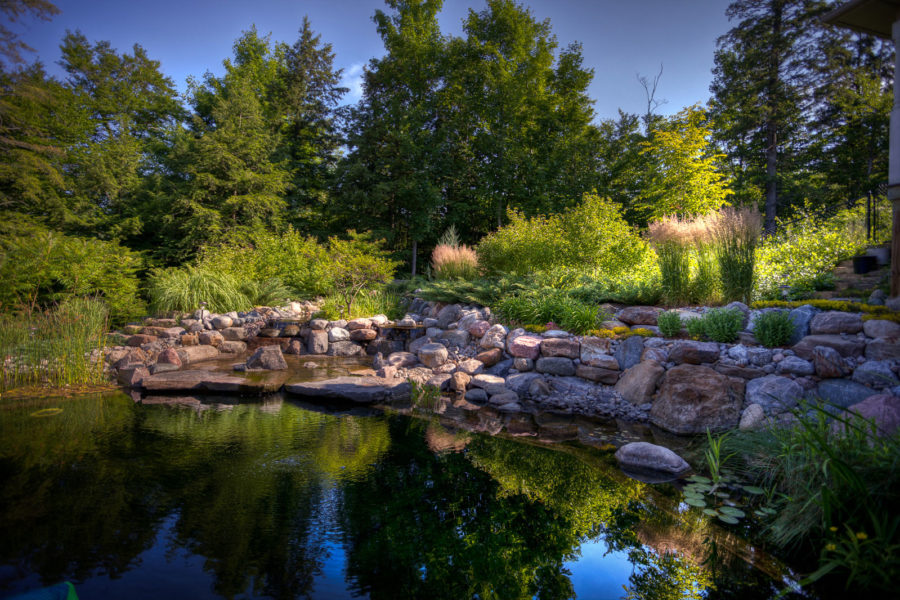
Retention ponds are one of the most common types of stormwater retention systems. Photo courtesy of Flickr
As the most common and recognizable method for retaining stormwater, retention ponds are man-made basins designed to hold large pools of water. Retention ponds may be created in three ways: by taking advantage of naturally occurring depressions, excavating new depressions, or constructing embankments. Existing natural ponds should never be used as stormwater retention basins, as runoff-borne pollutants can lead to significant ecosystem disruption.
Retention ponds in humid regions typically require a drainage area—or the land area that feeds runoff into the basin—between 10 to 20 acres in order to maintain a permanent pool throughout the year; a larger or smaller drainage area may be required depending on regional climatic factors. Most retention ponds are constructed to intersect the groundwater table, as this helps to minimize infiltration losses and maintain adequate saturation during periods of low rainfall.
Like all stormwater retention systems, runoff diversion is the primary function of retention ponds, though they also help improve groundwater quality. The permanent pool of water serves to increase residence time, giving particulate matter plenty of time to settle and, in the case of organic matter, decay via the process of aerobic decomposition.
Aquatic and semi-aquatic plants also help to improve water quality by cycling and filtering pollutants as they absorb water and nutrients; fixed aquatic plants (or those which are entirely submerged) work to both filter and oxygenate the water, while emergent plants located closer to the shore serve to stabilize the sediment bed and improve water clarity. Vegetation buffers planted along the pond’s shoreline can also help remove pollutants before they even enter the pool while simultaneously helping to prevent erosion.
Due to their size, stormwater retention ponds can be difficult to incorporate into heavily urbanized areas; instead, it is recommended that runoff be diverted to retention ponds constructed along the outskirts of dense urban centers.
Stormwater Wetlands
Stormwater wetlands, or constructed wetlands, are very similar to retention ponds, though they typically place a higher focus on ecosystem replication and are not designed to hold the same depth of water. Like retention ponds, stormwater wetlands should be constructed where no wetland currently exists, as diverting runoff into an existing wetland can drastically alter its hydrology and compromise ecological stability.
Stormwater wetlands consist of two main sections: a pretreatment area and a treatment area.
- Pretreatment. The pretreatment section of a constructed wetland is designed to remove coarse sediment by way of settling; pretreatment is typically achieved via a forebay or small pool and makes maintenance much easier by preventing excessive silt buildup in the main pool.
- Treatment. Refers to the permanent pool of water where the majority of runoff-borne pollutants are filtered out through settling and sedimentation; typically consists of a series of very shallow (<6 inches) and moderately shallow (<18 inches) zones, which aid the treatment process and increase biodiversity through the provisioning of diverse habitats for vegetation and microbial life.
On average stormwater wetlands require a drainage area between 5 and 25 acres to maintain a permanent pool, though regions that receive less rainfall may need a larger area. When it comes to their slope and length-to-width ratio, stormwater wetlands should be longer than they are wide and constructed on an upstream slope of up to 15 percent to ensure water is adequately treated before eventually entering the groundwater table.
Because they are designed to replicate natural wetlands, stormwater wetlands are not recommended for use in regions with an arid climate, as this makes it extremely difficult for them to retain permanent pools of water. The shallow nature of constructed wetlands also makes them more susceptible to freezing, meaning they can be more challenging to maintain in cold climates.
Stormwater wetlands are also ill-suited for use in dense urban developments, as such locations typically lack the continuous land area necessary for proper wetland construction. In some cases, however, smaller pocket wetlands can be created by intersecting the bottom of the wetland with the groundwater table; this helps ensure a permanent pool of water while simultaneously reducing the amount of drainage area needed.
Wet Swales
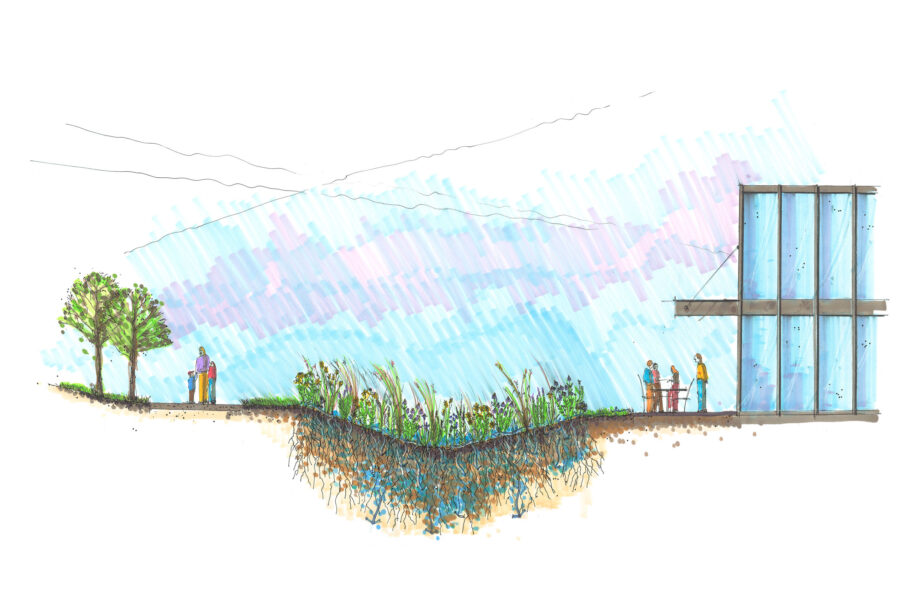
Drawing of a bioswale. Image courtesy of Jason Johnson Iowa NRCS, Flickr
A wet swale is a type of bioswale or shallow ditch that is designed to hold and slowly filter runoff throughout all or most of the year. They function almost identically to stormwater wetlands—they’re sometimes referred to as wetland channels—though they are much narrower, allowing them to be constructed alongside roadways and in medians. The contributing drainage area to a wet swale should be no more than 5 acres to prevent excessive flow rates and deep ponding.
Like stormwater wetlands, wet swales are shallow—typically holding only 6 inches of water—and as such, must be constructed in areas where the water table is located extremely close to the surface. Improper design or inappropriate placement of a wet swale will result in it draining completely between storm events, in which case it will no longer provide the necessary soil conditions for sustaining wetland vegetation.
Green Roofs

When equipped with a dedicated water retention membrane, green roofs can retain approximately 68% of all annual rainfall. Archatrak’s Oak porcelain pavers with pre-grown plant trays are seen here at the International Spy Museum in Washington DC. Photo courtesy of Archatrak
Green roofs represent something of a gray area when it comes to stormwater retention systems, as they are typically designed to both hold and release rainwater, essentially making them a cross between retention and detention systems. The roof’s growing medium will naturally soak up and retain some water, though the addition of a dedicated water retention membrane can help increase the amount of stormwater stored by green roof systems.
Water retention membranes come in a variety of forms, but typically consist of either felt geotextile mats or molded plastic sheets of alternating cups and drain holes—with regard to the latter, some water flows out through the drainage holes while the cups capture and store excess water, providing the plants with small reservoirs that may be drawn upon when necessary.
Columbia Green Technologies, for example, offers two green roof tray systems—the Pre-Grown Tray and Planted-in-Place Tray—with water retention capabilities. “These trays are typically capable of retaining an average of 70% of precipitation,” Malcolm Kay, CEO of Archatrak, previously wrote for gb&dPRO. “The pattern of micro-holes and continuous troughs in the base promotes the air flow necessary for plant growth and root health by preventing overly saturated media. The metered release of water allows plants ample time to uptake water and nutrients from the growing media without sitting in standing water.”
Current research shows that green roof systems—even shallow extensive ones—are capable of reducing stormwater runoff by anywhere from 35.5 to 100% during any given period of rainfall, resulting in an average of approximately 68% water retention annually.
Geocellular Storage Systems
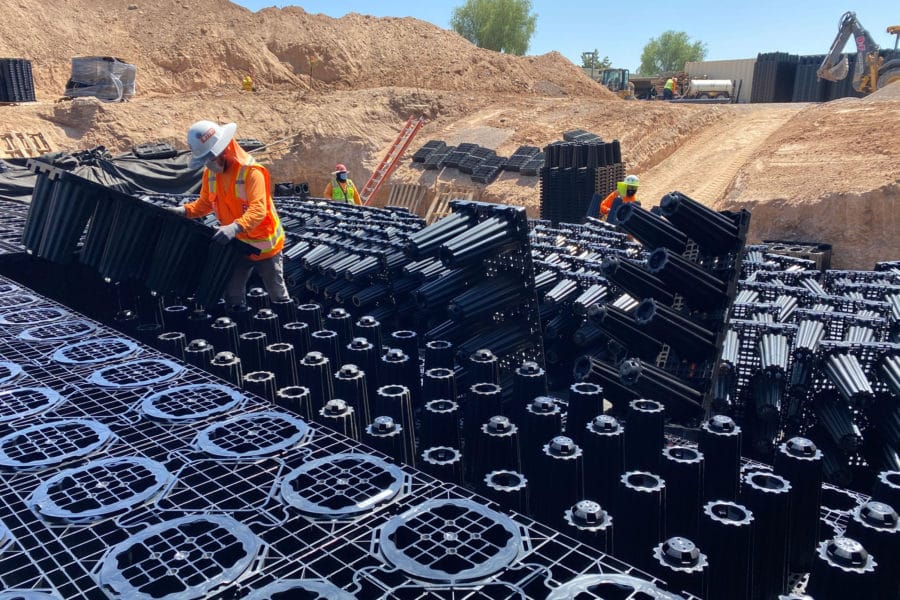
ACO StormBrixx SD system being brickbonded at Arizona State University in Tempe, Arizona. Photo courtesy of ACO
There are also various stormwater retention systems designed for underground installation. Geocellular storage systems are among the most popular.
Geocellular systems are modular, honeycomb-shaped constructs typically made from plastic that are installed underground above the water table; each honeycomb structure, or “cell,” in the system is capable of holding and retaining water. Depending on site-specific water management needs, geocellular systems can function as either soakaways or storage tanks—that is, they are capable of acting as either stormwater detention or retention devices.
ACO’s StormBrixx line of underground geocellular stormwater storage products, for example, provide solutions for water detention, retention, reuse, and infiltration. Made from a single recyclable polypropylene body, StormBrixx is an extremely versatile modular system that can be assembled in a variety of ways
StormBrixx was also engineered to be extremely maintenance-friendly—a quality many underground stormwater storage solutions lack. “ACO StormBrixx is designed to be open and accessible for maintenance and provide long-term benefits to the environment, the property owner, and those responsible for maintenance,” Kraig Smith, market segment manager at ACO, wrote in a previous gb&dPRO article. “Consistent upkeep once StormBrixx is installed means you won’t have to worry about the quality or quantity of water being stored and released.”
StormBrixx is just one link in the ACO system chain for stormwater management—before runoff actually enters the geocellular storage structure, it is collected via gullies, manhole covers, and drainage channels, all of which serve to divert and transport stormwater to an underground cleaning system that filters out sediment and large debris. From there the filtered rainwater is piped into the StormBrixx retention system, where it is stored until finally being pumped out for reuse in irrigation or other non-potable water systems.
Rainwater Catchment Devices
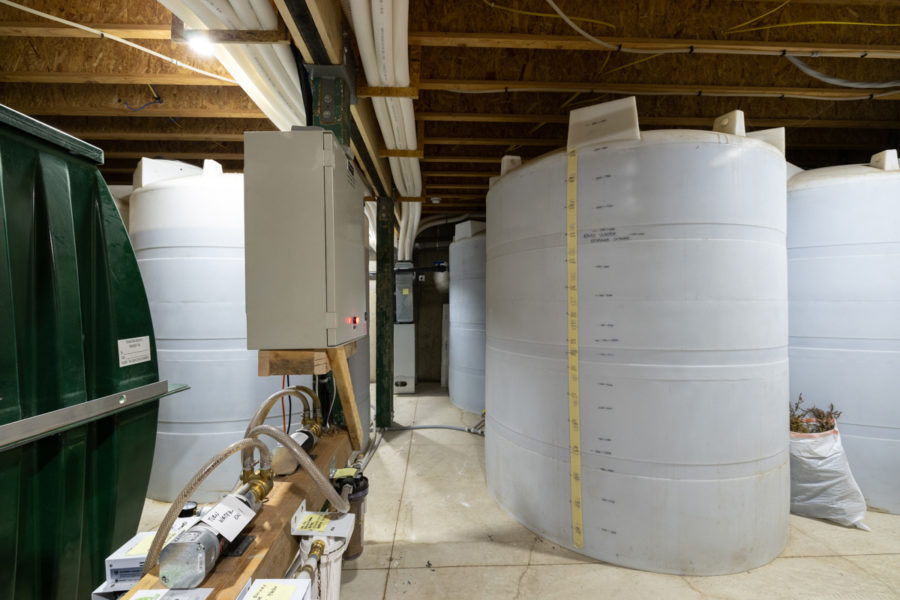
Urban Frontier House runs on runoff. The water is channeled underground to storage tanks in the basement. The water is stored in five storage tanks until needed. Photo by Nathan Satran
Depending on who you ask, rainwater harvesting—or the practice of collecting and storing rainwater for future use—can also be considered a form of stormwater retention. This includes both above- and below-ground storage devices, encompassing everything from the simple rain barrel to subterranean reservoirs designed to hold thousands of gallons of rainwater.
The Urban Frontier House in Montana, for example, is entirely water-autonomous thanks to its extensive rainwater harvesting system. Virtually 100% of the home’s water arrives in the form of rain or snow, all of which is stored in underground tanks with a combined capacity of 7,500 gallons. From there, the water is filtered, treated, and pumped to the residence’s potable water sources; all gray water that drains from these systems is then collected, filtered through a biological primary filtration system, disinfected, and reused for toilets, the dishwasher, washing machine, and irrigation.
Benefits of Stormwater Retention

Retention ponds, wet bioswales, green roofs, and other stormwater retention systems help reduce flood risk, improve water quality, increase biodiversity, and conserve water. Photo by Nic Lehoux
Stormwater retention systems are extremely useful stormwater management features, especially when it comes to public safety and flood prevention, but they also offer several other benefits as well.
Reduced Flood Risk
Their role in reducing the risk of flooding is perhaps the most important quality of stormwater retention systems. As we’ve already mentioned, stormwater retention systems serve to divert, capture, and store runoff that might otherwise enter municipal sewer systems or local water bodies. During periods of high rainfall, this diversion and retention of runoff helps prevent streams, rivers, and sewers from being over-inundated with water, reducing the potential for overflow and subsequent flooding.
Improved Water Quality
Because they hold water for extended periods of time, stormwater retention systems like ponds, wetlands, and wet swales help to improve groundwater quality by filtering out pollutants and contaminants present in runoff before they reach underground aquifers and reservoirs. Similarly, rainwater harvesting systems and geocellular storage systems both utilize filters to help remove sediment and debris before reuse.
Increased Biodiversity
Properly designed and maintained surface-level stormwater retention systems (i.e. green roofs, wet swales, stormwater wetlands, and retention ponds) also help to increase biodiversity by providing habitats for pollinators and other insects, birds, amphibians, and even fish, as well as a diverse array of aquatic and semi-aquatic plant species.
Water Conservation
By collecting and storing water, stormwater retention systems can help provide cities, building owners, and residents with additional water supplies for reuse in non-potable plumbing applications. This in turn conserves a higher percentage of treated, potable water for things like drinking, cooking, bathing, and washing.
Examples of Innovative Stormwater Retention in Action
As we’ve seen, stormwater retention systems are extremely useful features when implemented correctly—and the following projects showcase just how effective innovative stormwater retention measures can be.
Climate Pledge Arena, Seattle

Rainwater is collected from the Climate Pledge Arena’s roof, pre-filtered to remove any debris before entering a large underground cistern, and then released when needed into a smaller tank at the arena’s event level. There the water goes through a reverse osmosis purification system before being pumped into the electric Zambonis used for ice resurfacing. Photo by Ema Peter
Designed by global architecture firm Populous, the Climate Pledge Arena—named after The Climate Pledge founded by Amazon and Global Optimism in 2019—is a spectator space like no other and the first arena ever to achieve Zero Carbon Certification from the International Living Future Institute.
“We were very intentional about the ways we thought about sustainable design with Climate Pledge,” Geoff Cheong, a senior principal at Populous, previously told gb&d. The arena’s innovative “Rain-to-Rink” system, for example, captures rainwater from the roof in a 15,000 gallon cistern; the collected water is then purified, pumped into the arena’s electric Zamboni, and used to make the ice for the building’s NHL rink. “It’s a really incredible story and strategy, and we’re always excited to share about it,” Cheong says.
Beyond rainwater harvesting, the project also includes significant onsite retention tanks to help reduce runoff and prevent flooding.
Engineering Innovation Hub, New Paltz, NY

The new LEED Gold–certified Engineering Innovation Hub (EIH) building at the State University of New York (SUNY) at New Paltz was designed by Urbahn Architects and features a large stormwater retention pond. Photo by Leon Hordijk
Designed to LEED Gold standards by Urbahn Architects for the State University of New York at New Paltz, the Engineering Innovation Hub (EIH) has no shortage of sustainable features.
Built atop a former parking lot, the two-story EIH building employs several strategies to address the LEED category of Sustainable Sites and Water Efficiency.
Landscaped bioswales, for example, collect and redirect runoff into a 45-foot-long stormwater retention pond equipped with both a weir and overflow gate to control discharge. Any groundwater present underneath the building itself is drawn into the pond via a perforated pipe, helping to prevent a rise in hydrostatic pressure that might otherwise introduce moisture into the building.
Khoo Teck Puat Hospital, Yishun, Singapore
Designed by Robert Matthew Johnson Marshall (RMJM) Architects in collaboration with CPG Consultants, Khoo Teck Puat Hospital leverages stormwater retention to its advantage in more ways than one.
An existing stormwater pond adjacent to the initial build site was converted into a park that now serves the greater community. Native plant species were introduced to help clean the pond and foster biodiverse habitat growth, while walking trails were established in order to link the pond to the hospital and a nearby residential development.
Thanks to Khoo Teck Puat Hospital’s V-shaped layout, breezes are able to first skim over the stormwater pond before bringing cool, fresh air to the hospital’s patients via natural ventilation.

